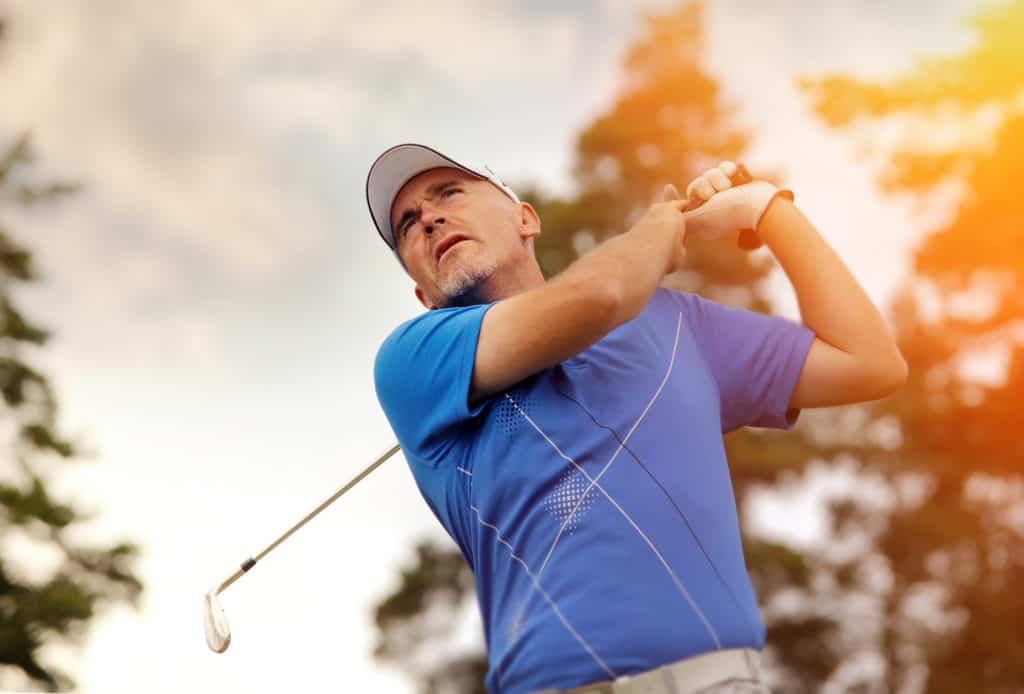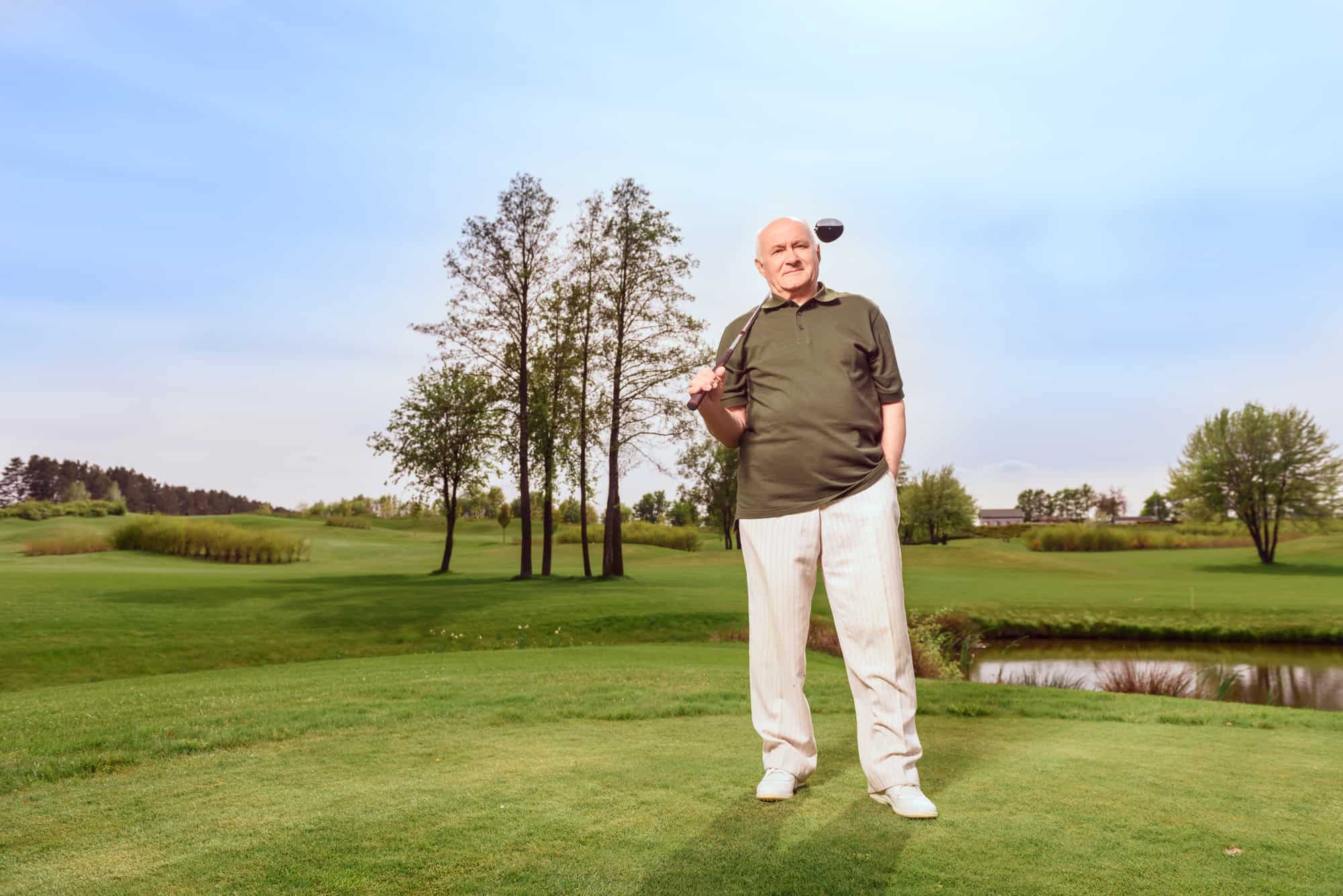
Golfers who are new to the game may think that there is one golf swing to learn.
This is not the case.
There are different golf swings that players must learn, and sometimes the swing itself will change a little from club to club.
We have put together a guide that helps you understand the different types of the golf swing and some information on how they may change as you change clubs.
If you are new to golf, this will be a great source of information to make this game make a little bit more sense.
Types of Golf Swings
Backswing

One type of golf swing is the backswing.
The backswing is considered to be the swing that takes you from the address position to the top of your golf swing.
The backswing is going to be quite different, depending on the type of player you are and your strengths and weaknesses.
The most important part of the backswing is the takeaway.
The takeaway is the first few inches of your swing.
If you take the club back too far inside or too far outside, it can throw off the rest of your golf swing.
All golfers need to practice their takeaway and make sure they are on the proper path as their swing starts.
Another factor to keep in mind in your backswing is the turn.
For the club to end up at the top of the backswing, there needs to be a rotation of the body.
If your body stays entirely still and there is no rotation or weight transfer, the results will be quite poor, and the club won’t get into the proper position.
As you swing the club back, the weight will transfer to your right foot (for right-handed golfers), and your hip will turn away from the ball.
At the top of the backswing, the club is going to be parallel to the ground, your head will still be pointed down at the golf ball, and some of your weight will have transferred to your back foot.
Once the backswing is complete, then the golfer will have to transfer into the downswing.
Video guide for the Backswing
Downswing

The downswing starts when the backswing ends.
There is usually a bit of a transition from the backswing to the downswing.
When starting the downswing, the golfer will have a club above their head at an angle parallel to the ground.
The downswing starts in several different ways depending on the level of the golfer and their particular swing mechanics.
For most players, the downswing should start with a turn of the body.
As the body starts to turn, the club will fall into place.
When the club falls into place, it will eventually head back down towards the golf ball.
Some players try to start their downswing with their hands and arms.
This is not always that effective and could cause the timing in the swing to go off.
When downswings are started with the hands, the club also usually ends up going above the plan as opposed to staying on plane.
The end of the downswing is the impact position.
When a golfer is at the impact, they have transferred some of their weight to the left foot.
The golfer’s head is going to be behind the golf ball.
The left-arm will be extended and stretched out in front of the player.
The clubhead on the golf club will be square to the target as opposed to being open or shut.
Video guide for the Downswing
Follow Through

After you have hit the golf ball, your follow-through begins.
With all of the momentum and power that you have in your swing from the backswing and downswing, there needs to be follow-through.
Stopping at the golf ball is not going to be nearly as effective, and it would also be almost impossible to stop the clubhead traveling at a high rate of speed.
When you think of other sports, there is almost always a follow-through.
When you throw a ball, there is a follow-through.
When you kick a ball, there is a follow-through.
When you swing a tennis racket, there is a follow-through.
When it comes to golf, making sure that your follow-through is effective and mechanically correct is quite essential.
During the follow through the rest of your weight will transfer to your left side.
When you have completed the follow through your weight should be on your left foot.
Your body will have turned to face the target at this point.
Your hands and arms will be raised and up by your ear while you watch your shot.
Many golfers get stuck with this concept of keeping their heads down when they swing.
This can get players to be stuck at the impact position, and it will significantly affect the ball flight and distance that they get with their golf clubs.
Your head should be down while you strike the golf ball, you should think about seeing the hit.
Once this part of the swing is complete, your head will turn up and watch the golf ball continue; it’s the way.
You may be wondering why follow-through is so important if it is after the golf ball has already been struck.
The reason is that if you are already stopping or manipulating your follow-through, the impact position will be affected.
Video guide for the Follow Through
Punch Swing

A punch type swing will have an abbreviated backswing and an abbreviated follow-through.
A punch type swing will keep the ball lower, and you will generally get quite a bit of rollout of a shot like this.
The punch type swing is going to work best for when you are playing in the wind or the rain.
Keeping the ball out of the air is essential.
A punch type swing can also help players get out of trouble if their ball should end up in the woods.
Even though a punch swing is abbreviated, there is still quite a bit of power on both sides of the swing.
This is different than a chip or a putt where feel and control is more important than
Video guide for the Punch Swing
Shorter Swing For Chipping/Pitching

The swings use for chipping and pitching shots are abbreviated versions of the full swing.
For a short chip shot, you will take a short backswing and a short follow-through.
All of the fundamentals, including your stance, your setup, and your weight transfer, are going to be very similar.
When hitting chips and pitches, the movements are more compact, and they will take time to perfect.
Sometimes you can get away with your full swing begin a little off; however if your chipping or pitching game is off, it is likely going to be very noticeable.
These swings are the most important to perfect because they are going to help you score.
Many new golfers get overwhelmed, thinking that they need to learn all of these new golf swings in combination with their full swing.
You should always develop solid fundamentals so that you can go back to those regardless of the type of shot that you are hitting.
When you break down the pieces of a chipping and pitching swing, you will see that they are identical to those of the full swing
Modern Golf Swing vs. Traditional Golf Swing

The golf swing has evolved a great deal through the years.
When you look back in history, you will notice that the early swings were very long.
The club went very far past parallel in the back.
Golfers swings looked loopy and flowing, and there was lots of room for error, but these players still learned how to time their swings properly.
From there, things started to get more compact.
Players made shorter swings but saw more consistent results.
This was when concepts like stack and tilt became popular, and people started realizing that sometimes less is more.
The only problem with the more compact swings is that it cost some golfers distance.
Unless you were in really get physical condition and your turn was very efficient, you could struggle with the shorter swings.
In the modern-day golf world, distance seems to be a significant factor.
Where golfers could win tournaments with controlled swings in the past, they need the distance now to get the job done.
Even in college golf, kids are driving the ball 300 plus yards.
This has led to golf swings that are built with power in mind.
Some players are starting to go a bit past parallel in the back, but they are timing it correctly to get the distance they need.
Players are also starting to get much more physical in the game of golf.
They are working out, exercising, and eating right so that they can perform at a much higher level.
What Makes Golf Swings Different?

Each golf swing is very different.
Golf swings are different because of players that have varying strengths and weaknesses.
Some golfers are good at hand-eye coordination, but their balance is off.
Some golfers have trouble when it comes to timing, but their mechanics are excellent.
Between different body types and various types of swings, all golf swings can look different.
If you go to take a golf lesson, the golf pro should work with the strength and weaknesses that you have so that hopefully, your game can improve.
If you are trying to learn or copy one particular swing, it can be quite tricky if it is not a good fit for your attributes.
Is It Difficult To Change Your Golf Swing?

It is not difficult to make subtle changes to a golf swing.
If, however, you are going to try and completely change your swing to something that is not natural to you, then it can be challenging.
If you ever hear one of your friends say that they are “starting from scratch,” they are in for a long process.
Golf swing changes should be made slowly, and they should be made one at a time.
If you need to work on the plane in your backswing and your follow-through, start with the plane and then adjust the follow-through.
Does the Golf Swing Change When You Use Different Clubs?

When you hit a driver, you are going to want to make sure that you hit the ball on your upswing.
When hitting with a wedge, you need to hit down and through the shot.
Since these two types of shots would seem like you need a different swing to complete them, some golfers get overwhelmed.
The truth is, you can make slight modifications in your golf setup and stance so that your swing does not need to change.
To hit a driver shot, you should play the ball off of your left foot.
To hit a wedge shot, the ball should be towards the middle of your stance.
When you make these adjustments, the plane/angle that you will need to swing on will naturally change.
Now you can use that same backswing, downswing, and follow-through that you always use to hit great shots.
How Do I Know Which Swing is Best For Me?

This is the golden question that all golfers wish they knew.
Is it better for your game to have a wide and flowing swing, or is it best to have a more compact swing.
There is no right or wrong answer, but you should try and determine what you are naturally good at.
Don’t try and read a book and figure your golf swing-out.
Go to the driving range and start experimenting with different shots and different ways of controlling your swing.
If you find that you do better with something shorter and more controlled, stick with it.
If you think that the longer swings help you have better timing than work with that.
If you watch the professional golfers play, you will see the different types of swings they have.
You can try and relate to a player based on body style and natural athletic ability to help give you some ideas about which swing could work best for you.



Leave a Reply